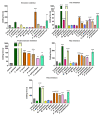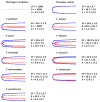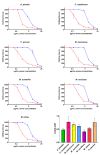Differential Antivenom and Small-Molecule Inhibition of Novel Coagulotoxic Variations in Atropoides, Cerrophidion, Metlapilcoatlus, and Porthidium American Viperid Snake Venoms
- PMID: 35893753
- PMCID: PMC9332056
- DOI: 10.3390/toxins14080511
Differential Antivenom and Small-Molecule Inhibition of Novel Coagulotoxic Variations in Atropoides, Cerrophidion, Metlapilcoatlus, and Porthidium American Viperid Snake Venoms
Abstract
Within Neotropical pit-vipers, the Mexican/Central-American clade consisting of Atropoides, Cerrophidion, Metlapilcoatlus, and Porthidium is a wide-ranging, morphologically and ecologically diverse group of snakes. Despite their prevalence, little is known of the functional aspects of their venoms. This study aimed to fill the knowledge gap regarding coagulotoxic effects and to examine the potential of different therapeutic approaches. As a general trait, the venoms were shown to be anticoagulant but were underpinned by diverse biochemical actions. Pseudo-procoagulant activity (i.e., thrombin-like), characterized by the direct cleavage of fibrinogen to form weak fibrin clots, was evident for Atropoides picadoi, Cerrophidiontzotzilorum, Metlapilcoatlus mexicanus, M. nummifer, M. occiduus, M. olmec, and Porthidium porrasi. In contrast, other venoms cleaved fibrinogen in a destructive (non-clotting) manner, with C. godmani and C. wilsoni being the most potent. In addition to actions on fibrinogen, clotting enzymes were also inhibited. FXa was only weakly inhibited by most species, but Cerrophidion godmani and C. wilsoni were extremely strong in their inhibitory action. Other clotting enzymes were more widely inhibited by diverse species spanning the full taxonomical range, but in each case, there were species that had these traits notably amplified relatively to the others. C. godmani and C. wilsoni were the most potent amongst those that inhibited the formation of the prothrombinase complex and were also amongst the most potent inhibitors of Factor XIa. While most species displayed only low levels of thrombin inhibition, Porthidium dunni potently inhibited this clotting factor. The regional polyvalent antivenom produced by Instituto Picado Clodomiro was tested and was shown to be effective against the diverse anticoagulant pathophysiological effects. In contrast to the anticoagulant activities of the other species, Porthidium volcanicum was uniquely procoagulant through the activation of Factor VII and Factor XII. This viperid species is the first snake outside of the Oxyuranus/Pseudonaja elapid snake clade to be shown to activate FVII and the first snake venom of any kind to activate FXII. Interestingly, while small-molecule metalloprotease inhibitors prinomastat and marimastat demonstrated the ability to prevent the procoagulant toxicity of P. volcanicum, neither ICP antivenom nor inhibitor DMPS showed this effect. The extreme variation among the snakes here studied underscores how venom is a dynamic trait and how this can shape clinical outcomes and influence evolving treatment strategies.
Keywords: anticoagulant; antivenom; procoagulant; pseudo-procoagulant.
Conflict of interest statement
The authors declare no conflict of interest.
Figures








Similar articles
-
Comparative Analysis of Alpha-1 Orthosteric-Site Binding by a Clade of Central American Pit Vipers (Genera Atropoides, Cerrophidion, Metlapilcoatlus, and Porthidium).Toxins (Basel). 2023 Aug 2;15(8):487. doi: 10.3390/toxins15080487. Toxins (Basel). 2023. PMID: 37624244 Free PMC article.
-
Tailored toxins: Coagulotoxic variations in Atropoides, Cerrophidion, Metlapilcoatlus, and Porthidium viperid venoms against diverse vertebrate plasmas.Toxicon. 2025 Sep;264:108453. doi: 10.1016/j.toxicon.2025.108453. Epub 2025 Jun 9. Toxicon. 2025. PMID: 40499795
-
Ontogenetic variation in coagulotoxic activity and antivenom efficacy of Central American pit viper venoms (Cerrophidion, Metlapilcoatlus, Ophryacus and Porthidium).Biochimie. 2025 Aug;235:49-58. doi: 10.1016/j.biochi.2025.05.009. Epub 2025 May 27. Biochimie. 2025. PMID: 40441522
-
Venomous snakes of Costa Rica: biological and medical implications of their venom proteomic profiles analyzed through the strategy of snake venomics.J Proteomics. 2014 Jun 13;105:323-39. doi: 10.1016/j.jprot.2014.02.020. Epub 2014 Feb 24. J Proteomics. 2014. PMID: 24576642 Review.
-
De Novo Assessment and Review of Pan-American Pit Viper Anticoagulant and Procoagulant Venom Activities via Kinetomic Analyses.Toxins (Basel). 2019 Feb 6;11(2):94. doi: 10.3390/toxins11020094. Toxins (Basel). 2019. PMID: 30736322 Free PMC article. Review.
Cited by
-
Breaking muscle: neurotoxic and myotoxic effects of Central American snake venoms and the relative efficacies of antivenom and varespladib.BMC Biol. 2024 Oct 23;22(1):243. doi: 10.1186/s12915-024-02044-3. BMC Biol. 2024. PMID: 39443999 Free PMC article.
-
Comparative Analysis of Alpha-1 Orthosteric-Site Binding by a Clade of Central American Pit Vipers (Genera Atropoides, Cerrophidion, Metlapilcoatlus, and Porthidium).Toxins (Basel). 2023 Aug 2;15(8):487. doi: 10.3390/toxins15080487. Toxins (Basel). 2023. PMID: 37624244 Free PMC article.
-
Tiny but Mighty: Vipera ammodytes meridionalis (Eastern Long-Nosed Viper) Ontogenetic Venom Variations in Procoagulant Potency and the Impact on Antivenom Efficacies.Toxins (Basel). 2024 Sep 14;16(9):396. doi: 10.3390/toxins16090396. Toxins (Basel). 2024. PMID: 39330854 Free PMC article.
-
Consistent Killers: Conservation of Thrombin-Like Action on Fibrinogen by Bushmaster (Lachesis Species) Venoms Underpins Broad Antivenom Cross-Reactivities.Toxins (Basel). 2025 May 2;17(5):224. doi: 10.3390/toxins17050224. Toxins (Basel). 2025. PMID: 40423307 Free PMC article.
-
Blood Lines: Intraspecific and Interspecific Variations in Anticoagulant Actions of Agkistrodon Viperid Venoms.Toxins (Basel). 2024 Jun 26;16(7):291. doi: 10.3390/toxins16070291. Toxins (Basel). 2024. PMID: 39057931 Free PMC article.
References
-
- Neri-Castro E., Bénard-Valle M., de León J.L., Boyer L., Alagón A. Handbook of Venoms and Toxins of Reptiles. CRC Press; Boca Raton, FL, USA: 2021. Envenomations by Reptiles in Mexico; pp. 529–542.
-
- Gutiérrez J. Handbook of Venoms and Toxins of Reptiles. CRC Press; Boca Raton, FL, USA: 2009. Snakebite envenomation in Central America; pp. 491–507.
-
- Boyer L., Alagón A., Fry B.G., Jackson T.N.W., Sunagar K., Chippaux J.P. Signs, Symptoms and Treatment of Envenomation. In: Fry B.G., editor. Venomous Reptiles and Their Toxins: Evolution, Pathophysiology and Biodiscovery. Oxford University Press; New York, NY, USA: 2015. pp. 32–60.
-
- Mackessy S.P. Handbook of Venoms and Toxins of Reptiles. CRC Press; Boca Raton, FL, USA: 2016.
Publication types
MeSH terms
Substances
LinkOut - more resources
Full Text Sources
Research Materials
Miscellaneous

